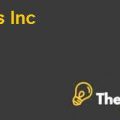
Syntex Laboratories Case (A) Case Solution
Syntex Lab
Russell Marker founded Syntex Corporations in 1940. Their main products were oral contraceptives and topical steroids, prescribed by gynecologists and skin specialists respectively. The company grew to a large level by performing well in the pharmaceutical industry. The company reported sales of $710.9 million with net earnings of $98.6 million in the year 1981. However, this was not the end to this. It still maintained a good growth rate throughout their history. Syntex Corporations’ largest subsidiary was Syntex Laboratories. It had the largest contribution in its revenues. This subsidiary was performing the functions of developing, manufacturing, and marketing anti-inflammatory drugs. Their success largely was the result of their research department, which was working tirelessly to improve the current products and working on new therapeutic areas like immunology, viral, and cardiovascular domain. Their main products were Naprosyn, Anaprox, Topical Steroids, Norinyl, and Nosalide.
Problems Faced by Syntex Lab
Syntex was a large firm with huge amount of volumes sold in the market. It had a good network of Sales reps working for them, whose responsibilities included meeting the physicians and specialists and introducing and convincing them to prescribe their represented products. Currently it has 433 Sales representatives, also known as rep. They deployed on different products and were duty bound to make seven calls daily. They usually faced problems like unresponsiveness from the Physicians. Physicians were very busy in their work and this required waiting for them. Decided strategy was to make the sales call once in six weeks. There were around 70,000 practicing physicians targeted. This 433-numbered sales force was very small as compared to the competitors (Exhibit A). Merck only had 955 sales persons to cover their Non-steroidal anti-inflammatory drug market. There were 135,229 office-based physicians in the market. Targeting this much huge number roughly required around 1200 reps deployed in the market. This estimate was way beyond the level in the competitive market. Another challenge was of geography. There are 50 states and numerous towns in them. This vast level needed covering by the sales team.
From the given material’s analysis, following are the main problems faced by Syntex Laboratories in sales department
- Sales Force Building
- Sales ForceAllocation
- Frequency of Sales Calls
- Geographic Coverage
All these problems were resulting into loss of potential sales. Sales calculations and product wise allocation of sales force is in Exhibit A.
Solutions
Syntex had a very good name in the market, which made the flow easy through the market. They had a huge potential in the market. That potential needed monetization to increase the profits. For approaching the solution to the current problems, Sales Force Management Decision model is applied.
After detailed demand,the analysis for the sales force resulted in the figure of 708 sales reps deployed in the market. Sales person’s deployment is according to territories. One for each small territory or if the territory is dense, there can be two sales reps allocated there. These Sales Reps will report to their area sales manager who will be one for each state. Territory is the area having at least 70 office-based physicians of specific medicine’s domain...................
This is just a sample partial case solution. Please place the order on the website to order your own originally done case solution.









